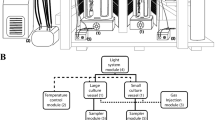Abstract
Biological energy-conversion systems are attractive in terms of their self-sustaining and self-organizing nature and are expected to be applied to low-cost and environment-friendly processes. Here we show a biofilm-based light/electricity-conversion system that was self-organized from a natural microbial community. A bioreactor equipped with an air cathode and graphite-felt anode was inoculated with a green hot-spring microbial mat. When the reactor was irradiated with light, electric current was generated between the anode and cathode in accordance with the formation of green biofilm on the anode. Fluorescence microscopy of the green biofilm revealed the presence of chlorophyll-containing microbes of ∼10 µm in size, and these cells were abundant close to the surface of the biofilm. The biofilm community was also analyzed by sequencing of polymerase chain reaction-amplified small-subunit rRNA gene fragments, showing that sequence types affiliated with Chlorophyta, Betaproteobacteria, and Bacteroidetes were abundantly detected. These results suggest that green algae and heterotrophic bacteria cooperatively converted light energy into electricity.




Similar content being viewed by others
References
Akai J, Akai K, Ito M, Nakano S, Maki Y, Sasagawa I (1999) Biologically induced iron ore at Gunma iron mine, Japan. Am Mineral 84:171–182
Chaudhuri SK, Lovley DR (2003) Electricity generation by direct oxidation of glucose in mediatorless microbial fuel cells. Nat Biotechnol 21:1229–1232
Cheng S, Liu H, Logan BE (2006) Increased performance of single-chamber microbial fuel cells using an improved cathode structure. Electrochem Commun 8:489–494
Das D, Veziroglu TN (2001) Hydrogen production by biological processes: a survey of literature. Int J Hydrogen Energy 26:13–28
Doemel WN, Brock TD (1977) Structure, growth, and decomposition of laminated algal–bacterial mats in alkaline hot springs. Appl Environ Microbiol 34:433–452
Donohue TJ, Cogdell RJ (2006) Microorganisms and clean energy. Nat Rev Microbiol 4:800
Dopheide A, Lear G, Stott R, Lewis G (2008) Molecular characterization of ciliate diversity in stream biofilms. Appl Environ Microbiol 74:1740–1747
Fahrénbruch AL, Bube RH (1983) Fundamentals of solar cells: photovoltaic solar energy conversion. Academic, New York
Finneran KT, Johnsen CV, Lovley DR (2003) Rhodoferax ferrireducens sp. nov., a psychrotolerant, facultatively anaerobic bacterium that oxidizes acetate with the reduction of Fe(III). Int J Syst Evol Microbiol 53:669–673
Garrity GM, Bell JA, Lilburn T (2005) Class II. Betaproteobacteria class. nov. In: Brenne DJ, Krieg NR, Staley JT (eds) In Bergey's manual of systematic bacteriology, vol 2 (The Proteobacteria), 2nd edn. Springer, New York, p 575
Gust D, Moore TA, Moore LA (1993) Molecular mimicry of photosynthetic energy and electron transfer. Accounts Chem Res 26:198–205
He Z, Kan J, Mansfeld F, Angenent LT, Nealson KH (2009) Self-sustained phototrophic microbial fuel cells based on the synergistic cooperation between photosynthetic microorganisms and heterotrophic bacteria. Environ Sci Technol 43:1648–1654
Karlin S, Altschul SF (1990) Methods for assessing the statistical significance of molecular sequence features by using general scoring schemes. Proc Natl Acad Sci U S A 87:2264–2268
Logan BE, Hamelers B, Rozendal R, Schröder U, Keller J, Freguia S, Aelterman P, Verstraete W, Rabaey K (2006) Microbial fuel cells: methodology and technology. Environ Sci Technol 40:5181–5192
Lombardi AT, Hidalgo TM, Vieira AA (2005) Copper complexing properties of dissolved organic materials exuded by the freshwater microalgae Scenedesmus acuminatus (Chlorophyceae). Chemosphere 60:453–459
Malik S, Drott E, Grisdela P, Lee J, Lee C, Lowy DA, Gray S, Tender LM (2009) A self-assembling self-repairing microbial photoelectrochemical solar cell. Energy Environ Sci 2:292–298
Moore BG, Tischer RG (1965) Biosynthesis of extracellular polysaccharides by the blue-green alga Anabaena flosaquae. Can J Microbiol 11:877–885
Nübel U, Bateson MM, Vandieken V, Wieland A, Kühl M, Ward DM (2002) Microscopic examination of distribution and phenotypic properties of phylogenetically diverse Chloroflexaceae-related bacteria in hot spring microbial mats. Appl Environ Microbiol 68:4593–4603
Pankratov TA, Kulichevskaya IS, Liesack W, Dedysh SN (2006) Isolation of aerobic, gliding, xylanolytic and laminarinolytic bacteria from acidic Sphagnum peatlands and emended description of Chitinophaga arvensicola Kampfer et al. 2006. Int J Syst Evol Microbiol 56:2761–2764
Prince RC, Kheshgi HS (2005) The photobiological production of hydrogen: potential efficiency and effectiveness as a renewable fuel. Crit Rev Microbiol 31:19–31
Rosenbaum M, Schröder U, Scholz F (2005) In situ electrooxidation of photobiological hydrogen in a photobioelectrochemical fuel cell based on Rhodobacter sphaeroides. Environ Sci Technol 39:6328–6333
Shihara J, Krauss RW (1965) Chlorella. Port City Press, Maryland
Sly LI, Taghavi M, Fegan M (1999) Phylogenetic position of Chitinophaga pinensis in the Flexibacter–Bacteroides–Cytophaga phylum. Int J Syst Bacteriol 49:479–481
Strik DP, Terlouw H, Hamelers HV, Buisman CJ (2008) Renewable sustainable biocatalyzed electricity production in a photosynthetic algal microbial fuel cell (PAMFC). Appl Microbiol Biotechnol 81:659–668
Tamura K, Dudley J, Nei M, Kumar S (2007) MEGA4: molecular evolutionary genetics analysis (MEGA) software version 4.0. Mol Biol Evol 24:1596–1599
Tanaka K, Tamamushi R, Ogawa T (1985) Bioelectrochemical fuel-cells operated by the cyanobacterium, Anabaena variabilis. J Chem Technol Biotechnol B 35:191–197
Ward DM, Olson GJ (1980) Terminal processes in the anaerobic degradation of an algal–bacterial mat in a high-sulfate hot spring. Appl Environ Microbiol 40:67–74
Watanabe K (2008) Recent developments in microbial fuel cell technologies for sustainable bioenergy. J Biosci Bioeng 106:528–536
Watanabe K, Watanabe K, Kodama Y, Syutsubo K, Harayama S (2000) Molecular characterization of bacterial populations in petroleum-contaminated groundwater discharged from underground crude oil storage cavities. Appl Environ Microbiol 66:4803–4809
Watanabe K, Kodama Y, Kaku N (2002) Diversity and abundance of bacteria in an underground oil-storage cavity. BMC Microbiol 2:23
Yagishita T, Sawayama S, Tsukahara K, Ogi T (1997) Effects of intensity of incident light and concentrations of Synechococcus sp. and 2-hydroxy-1, 4-naphthoquinone on the current output of photosynthetic electrochemical cell. Solar Energy 61:347–353
Acknowledgments
We thank Souichiro Kato for help in sampling and Greg Newton for critical reading of the manuscript. This work was supported by the Exploratory Research for Advanced Technology (ERATO) program of the Japan Science and Technology Agency (JST).
Author information
Authors and Affiliations
Corresponding authors
Rights and permissions
About this article
Cite this article
Nishio, K., Hashimoto, K. & Watanabe, K. Light/electricity conversion by a self-organized photosynthetic biofilm in a single-chamber reactor. Appl Microbiol Biotechnol 86, 957–964 (2010). https://doi.org/10.1007/s00253-009-2400-2
Received:
Revised:
Accepted:
Published:
Issue Date:
DOI: https://doi.org/10.1007/s00253-009-2400-2




